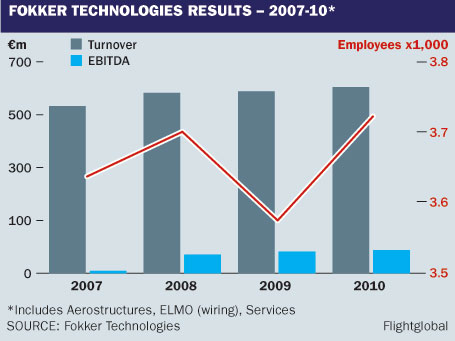Dutch group Stork's 2010 results note somewhat dryly of its Fokker Technologies division that: "The number of Fokker aircraft which remained in operational use dropped as a result of the slump in the airline industry. Although airlines are in a recovery phase, a sizable part of the [fleet] will not return to operation."
The company made its last aircraft with bankruptcy in 1996 and, revived by Stork, has since made a good business of maintaining Fokker aircraft, including the popular Fokker 100 regional jet. But, clearly, a business reliant on maintaining a dwindling fleet offers no long-term future. Or, as Roland van Dijk, president of the Fokker Services maintenance business, puts it: "The fleet will give in to gravity."
The business, however, is gaining altitude. A two-year push to transition Services from a Fokker-focused operation to one dedicated to out-of-production aircraft has been validated by a deal with Bombardier to developing a "power-by-the-hour" support programme for Dash 8 Q100/200/300 operators called Fly, modelled after the Abacus scheme for Fokker operators.
Out-of-production aircraft and their operators have unique demands. New aircraft are typically operated by large carriers with big in-house support, says Van Dijk, but that is not true of smaller operators that usually take on aircraft during the second half of their service lives. Here, one outside specialist capable of providing comprehensive support is important.
 |
|---|
And, he adds, the demands on that support specialist are unique for out-of-service aircraft. Parts can become scarce, but Fokker can maintain supply chains. Older aircraft still need upgrades, and Fokker is well placed to manage them, as it still has the "heart and soul" of an OEM.
At the sharp end of the business, Schiphol component repair services managing director Maarten van Marle notes that, as a specialist in out-of-production aircraft, Fokker's mentality is to repair, which is typically less costly than replacement.
Fokker Services engineers are different characters than their OEM counterparts. Van Marle describes them as more at home in the workshop, eager to devise "alternative repair" techniques for parts that many engineers would discard for replacement.
Another strength of the repair business is its battery of test equipment dedicated to out-of-production components and systems. Some of this kit is held over from Fokker's manufacturing days.
Today, 10% of Fokker Services' new business is linked to non-Fokker aircraft, but van Marle is looking for 50% in five years and the component repair business has established a separate sales team for non-Fokker customers. Again, the objective is to remain in business even when the Fokker fleet is no longer flying, and van Marle, too, sees the Fokker difference being the company's legacy as an OEM: "We know how an aircraft works and is operated."
HALF THE FLEET
Sjoerd Vollebregt, chief executive of Fokker Technologies and Stork, notes that half the world's fleet consists of out-of-production aircraft, so is optimistic about doubling the business in four to five years, including by acquisition. A key strategy, he says, is to not operate the Aerostructures, ELMO wiring and Services business as "silos", but rather to find "bridges" between them to leverage Fokker's OEM legacy of "integrator know-how".
The Fokker 100 legacy lives on in Fokker's metal bonding technology which, while labour-intensive, made that aircraft lightweight, robust and repairable. Today at Papendrecht Fokker builds skin panels for the Airbus A380 using its Glare technology of glass reinforced aluminium, as well as Glare-skinned vertical and horizontal tails for Gulfstream. In the works are Airbus A350 outboard flaps and wiring systems for the Bombardier CSeries and Lockheed Martin F-35.
Source: Flight International



















